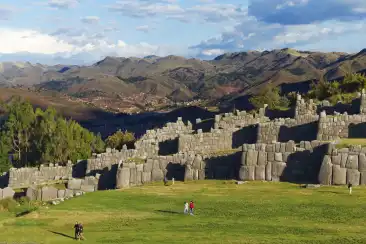Sacsaywaman

2 kilometers from the city of Cusco, on top of a mountain, stands
Sacsaywaman, at a height that dominates the entire city. The complex was
built by the Incas in the 15th century, particularly under Pachacuti
(Inca) and his successors.
The site is located at an altitude of
3,701 m (12,142 ft). The long zigzagging walls of more than 300 meters,
which border its 3 levels of terraces, are built with huge stone
monoliths, some of which are more than 9 meters high and weigh more than
100 tons. These huge monoliths are perfectly nestled next to each other
and, even more amazing, one on top of the other. Added to the power and
majesty that this megalithic Inca building transmits is the enigma of
its construction.
According to the chroniclers, Cusco was designed
following the representation of a puma. Sacsaywaman, "satisfied puma" in
Quechua, was the head of the sacred animal and the maximum expression
of the hanan sector (upper Cusco), where public ceremonies were held.
Surrounded by the apus (sacred mountains) Pachatusan, Ausangate, and
Cinca. It was made up of terraces, cemeteries, shrines, ritual
fountains, artificial lagoons, reservoirs, slides or slides,
astronomical observatories, and underground passages. According to local
legends, they lead to the Qoricancha, which would be the belly or
genitals of the puma.
In 1983, Cusco and Sacsayhuamán together were
designated as sites on the UNESCO World Heritage List, for international
recognition and protection.